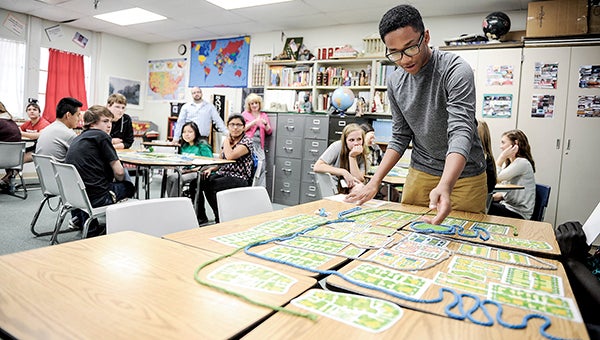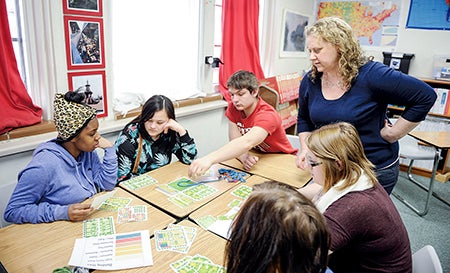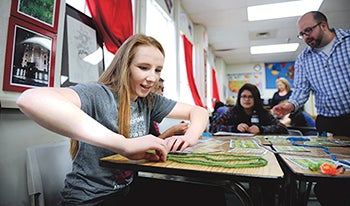Youth’s plan of the future; Comprehensive plan seeks input from students, tours Austin
Published 10:45 am Friday, April 15, 2016

Michael Vuong explains his group’s city complete with housing, parks, roads and waterways during a sophomore human geography class at Austin High School. The activity was put on by the comprehensive plan steering committee as a way to involve youth in how they think Austin should develop. Photos by Eric Johnson/photodesk@austindailyherald.com
Austin’s Comprehensive Plan, a guide for zoning and land use, is one step closer to being compiled into tangible ideas.
On Thursday, Lisa Sander’s sophomore human geography class at Austin High School put their design skills to the test with planning out how they would want their city to look in future years and then committee members and others took a tour of Austin to see issues and opportunities in each quadrant of the city.
Austin’s Planning and Zoning and Steering committees have been holding community meetings about quadrants of the city and they wanted to get students involved.
“This was our first test run of this activity,” Planning and Zoning Administrator Holly Wallace said. “We’re looking into the future. This will have a direct impact on the kids.”
Students worked in small groups of five for about 20 minutes playing “Austinopoly,” a land use game which let students design their own city. They used cards with city features printed on them such as residential housing, commercial and businesses.
They also had three different colored yarns to represent parks and green space, waterways and transportation.
After they laid out their city, the groups nominated a spokesperson to present their plan to the committee.
Sophomores Kevin Echeverria, Clayton Novak, Margarita Felipe, Rosalinda Vicente and Thaddeus Belden designed their city so the housing wasn’t clumped into groups and it was spread throughout the town. They also placed a strip mall by the old Target to “connect everything together out there.”
“We got to brainstorm and use our creativity,” Vicente said.
The students said they’d like to see more stores in Austin and maybe even a place to go mudding or dirt biking.

Austin Planning and Zone Administrator Holly Wallace watches Austin High School sophomores as they plan out their town, part of an activity by the comprehensive steering committee Thursday.
Sanders said the students have been studying urbanization and applied what they’ve learned about urban geography in class to the activity.
“They gain an understanding of why our city is the way it is,” she said.
SEH Inc. planners led the activity.
“You are our future leaders of the city,” SEH planner Bob Kost told the students. “We work together and negotiate what goes into the plan.”
The comprehensive plan helps guide discussions for land use, physical, social and economic development for the city’s future years. The plan is usually renewed every 10 to 15 years.
Touring Austin
After students gave their input, the committee toured each quadrant in Austin Thursday evening to identify issues and opportunities.
A group of about 15 community leaders discussed zoning, housing, businesses, green space and development around the city areas such as Cook Farms, the recently demolished Oak Park Mall, Wescott Athletic Complex, Ramsey Dam and other locations.
Wallace said it helped for them to be out on the street and see problems or opportunities with their own eyes and for everyone to be in a group generating more ideas.
“We generated a lot of discussion about issues and opportunities workshops and I think this helped kind of frame some of those ideas better and to maybe narrow the issues a little bit,” Wallace said.
Kost advised the group to focus rehab, regrowth and reinvestment in the city.
“It’s good to have areas of a mix of several uses,” Kost said. “You can mix old and new together.”
The same would go for new and existing housing to be tied together, he added.
Kost added there’s a lot of commercialization on 18th Avenue Northwest retail area near Wal-Mart but not a lot of residential to back it up. He also said a goal could be to change the city’s policy for big box marts like Target to put their buildings in escrow before they build.
In other words, if the larger companies move out in 10 years after building, the city could still tax empty buildings until it was reused.
Wallace said the experience was good to see in person.
“I think in this instance where we had a big group of people who have their various experiences with the city, we were able to inform each other a lot more about the history of the city and whether an opportunity [is tangible],” she said.
SEH planners will come back in May after they develop chapters with concrete ideas and the committees will meet again to look at the plans.






